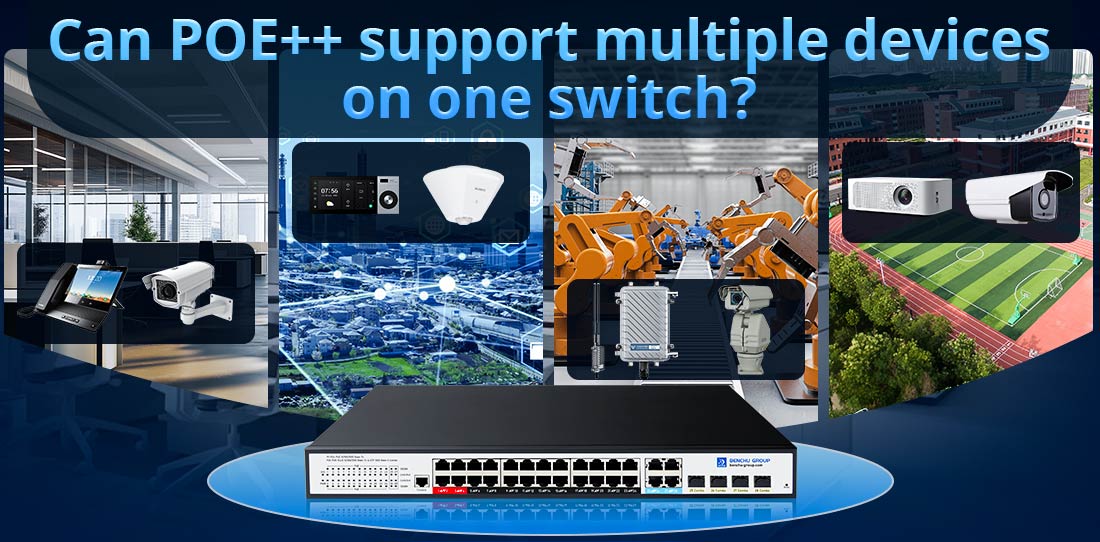
Sim, os switches PoE++ podem suportar vários dispositivos em um único switch, tornando-os uma solução versátil e eficiente para alimentar e conectar uma variedade de dispositivos em uma rede. A capacidade de suportar vários dispositivos depende de vários fatores, como o número de portas do switch, o orçamento de energia e os requisitos de energia dos dispositivos conectados. Abaixo está uma explicação detalhada:
1. Fornecimento de alta potência por porta
PoE++ Padrão (IEEE 802.3bt): Fornece até 90 W por porta de energia, permitindo suportar dispositivos com altas demandas de energia, como:
--- Câmeras PTZ com aquecedores.
--- Pontos de acesso sem fio com múltiplas antenas.
--- Iluminação ou displays LED inteligentes.
--- Dispositivos IoT de alto desempenho e sensores industriais.
Vários dispositivos: Dispositivos com requisitos de energia mais baixos, como telefones VoIP ou câmeras IP padrão, podem usar apenas 15–30 W, deixando mais energia disponível para dispositivos adicionais no mesmo switch.
2. Orçamento total de energia
O orçamento total de energia de um switch PoE++ é a quantidade combinada de energia que ele pode fornecer em todas as suas portas. Por exemplo:
Um switch PoE++ de 24 portas com orçamento de energia de 720 W pode, teoricamente, alimentar:
--- 8 dispositivos de 90W cada (720 ÷ 90 = 8).
--- 24 dispositivos de 30 W cada (720 ÷ 30 = 24).
O switch aloca energia dinamicamente com base nas necessidades de cada dispositivo, garantindo o uso eficiente de seu orçamento de energia.
3. Contagem de portas e densidade de dispositivos
Configurações típicas: Os switches PoE++ estão disponíveis em diversas configurações, como 8, 16, 24 ou 48 portas, permitindo alta densidade de dispositivos.
Flexibilidade para dispositivos mistos: O switch pode alimentar uma combinação de dispositivos de alta potência (por exemplo, câmeras ou monitores avançados) e dispositivos de baixa potência (por exemplo, sensores ou telefones) simultaneamente, desde que a demanda total de energia não exceda o orçamento de energia do switch.
4. Alocação e negociação de poder
Os switches PoE++ usam protocolos avançados de negociação de energia (como LLDP-MED ou detecção automática) para:
--- Detecte dispositivos conectados e seus requisitos de energia.
--- Aloque energia dinamicamente, garantindo uma entrega ideal.
--- Evite sobrecarga recusando-se a alimentar dispositivos se a demanda total exceder o orçamento disponível.
--- Isso garante uma operação segura e eficiente, mesmo em redes com diversos dispositivos.
5. Gerenciamento centralizado de energia
Um switch PoE++ simplifica o fornecimento de energia e dados para vários dispositivos:
--- Fonte de alimentação única: Elimina a necessidade de adaptadores de energia individuais, reduzindo a confusão e a complexidade.
--- Monitoramento Remoto: O uso de energia para cada porta pode ser monitorado através da interface de gerenciamento do switch.
--- Priorização de energia: Dispositivos de alta prioridade (por exemplo, câmeras de segurança) podem ser configurados para receber energia primeiro, caso a demanda total se aproxime do orçamento de energia do switch.
6. Eficiência de custos e infraestrutura
O suporte a vários dispositivos em um único switch PoE++ oferece diversas vantagens operacionais e de custo:
--- Custos de instalação reduzidos: São necessárias menos tomadas e cabos, economizando materiais e mão de obra.
--- Escalabilidade: Dispositivos adicionais podem ser conectados a portas não utilizadas sem modificar a infraestrutura de energia existente.
--- Gerenciamento eficiente de cabos: Os dados e a energia são fornecidos pelo mesmo cabo Ethernet, simplificando o design da rede.
7. Casos de uso adequados
Interruptores PoE++ são ideais para uma variedade de implantações em vários dispositivos, como:
--- Edifícios Inteligentes: Alimentando iluminação inteligente, controladores HVAC e sensores de ocupação.
--- Ambientes de escritório: Suporte a telefones VoIP, câmeras de vigilância e pontos de acesso sem fio.
--- Aplicações Industriais: Alimentando dispositivos IoT robustos e máquinas em rede.
--- Campi de Educação: Conectar e alimentar quadros inteligentes, projetores e câmeras em salas de aula.
--- Instalações de saúde: Suporte a sistemas de monitoramento de pacientes e sinalização digital.
8. Limitações a considerar
Embora os switches PoE++ sejam projetados para suporte a dispositivos de alta capacidade, há algumas limitações a serem lembradas:
--- Restrições do orçamento de energia: A potência total disponível é compartilhada entre todas as portas. Se a demanda combinada de energia exceder o orçamento, nem todos os dispositivos poderão ser alimentados simultaneamente.
--- Solução: Use switches com orçamentos de energia mais altos ou distribua dispositivos entre vários switches.
--- Comprimento do cabo: O alcance efetivo do PoE++ é limitado a 100 metros (328 pés) por lance de cabo. Além disso, são necessários extensores ou switches adicionais.
--- Gerenciamento de calor: Os switches PoE++ geram calor ao alimentar vários dispositivos, exigindo ventilação adequada ou soluções de resfriamento em configurações densas.
9. Exemplos de cenários multidispositivos
Switch PoE++ de 24 portas (orçamento de energia de 720 W):
--- 6 câmeras PTZ de 60W cada (360W no total).
--- 10 telefones VoIP de 15W cada (150W no total).
--- 8 pontos de acesso sem fio de 30 W cada (240 W no total).
Total: São necessários 750 W, o que excede o orçamento, portanto o administrador precisaria priorizar dispositivos ou redistribuir conexões.
Solução para excesso de demanda:
--- Adicione outro switch PoE++ ou um injetor midspan para energia adicional.
Conclusão
Os switches PoE++ são altamente capazes de suportar vários dispositivos em um único switch, desde que a demanda total de energia não exceda o orçamento de energia. Seu alto número de portas, gerenciamento avançado de energia e escalabilidade os tornam uma excelente opção para implantações de vários dispositivos em ambientes corporativos, industriais e inteligentes. O planejamento e o orçamento de energia adequados são essenciais para maximizar a eficiência e a confiabilidade de um switch PoE++ em cenários com vários dispositivos.